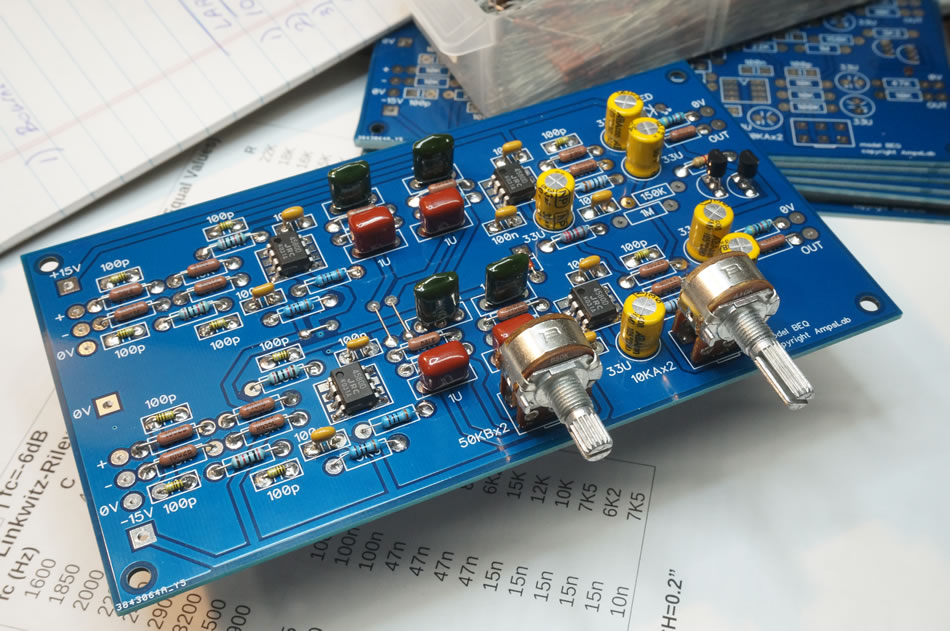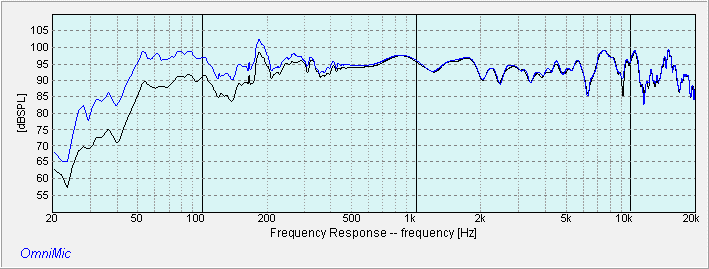|
Part 3 – PCB Testing My BassEQ pcbs finally arrived. They look beautiful. The photo below is with it populated. This is a stereo board. The two balanced inputs are on the left. Unbalanced outputs are on the right. The first potentiometer is the bass boost. Beside it is the output volume control. The next step is bench testing. If there are no issues, I will connect it to my system for a listen.
On the BenchI wired my signal generator to one of the inputs with the associated output hooked up to my scope. On powering up, there was a high frequency oscillation. Unbelievable. There wasn’t any in my hard wired prototype board but with this pcb, it’s there. I eventually traced the oscillation to the bass tone contour circuit. The NJM4580 was oscillating. After mulling over it for a day, I figured the 4580 needs a capacitor to stabilize her. I duly soldered a 33pF across her output to her inverting input and true enough, the oscillations vanished. The trace is really beautiful now. No garbage. Just a clean readout. Auditioning the BassEQWith the oscillations sorted out, I connected my pc balanced output to the balanced input of the BassEQ. The unbalanced output of the BassEQ to my power amplifier. Adjusted the Bass Boost to about 6dB and played some music. The sound is very clean, no humming or hiss. I had the music playing for a few days while I work in my lab. By the third day, I couldn’t help but wonder whether the music is lacking something. I do not recall the Osprey-12 sounding like this. The music doesn’t excite me anymore. The treble is there but is slightly muted. The vocals are not upfront enough. Overall, it sounds a bit “thin” and like there’s a slight veil over everything. It’s not very bad but just enough to take the shine of the music. I doubt this has to do with components. My guess is the op amps. Currently, they are all NJM4580. This is a very popular op amp, used in many well known mixers. It’s so popular than some mixers use this NJM4580 exclusively. Well, it may be the in-thing but that’s not the sound I’m looking for. I decided to replace the output op amp with a NE5532, reason being that this is the last op amp and it’s connected to the power amplifier. And I was right. The change was like night and day. Now the Osprey-12 sings. The dynamics and clarity came back. The music has more “body” too. BassEQ pcbsI am so pleased with this BassEQ that I will be offering the pcbs for sale. It will not be kits. Buyers will need to source their own components. This way, it’ll free me to develop other projects. This BassEQ pcb is not for the Osprey-12 only. It will restore the bass in many 2-way speakers. But use it carefully. Bass is addictive. It’s very easy to overdo the bass boost. I find 6dB boost is about right for 4 pi placement. Turning the bass pot full clockwise is about 10dB. You’ll get a lot of bass but the midrange and treble will recede into the background. BassEQ in Use
The Black plot above is the Osprey-12 driven directly with the power amplifier. Since the speaker is in 4 pi, the bass drops to about -5dB referenced to the midrange. The Blue plot is with the source playing through the BassEQ. The bass boost is clearly seen. This is actually too much for my taste. I had to turn it down by a couple of dBs for the right tonal balance. There is no right setting for bass. Every speaker is different, so as the room it’s in. You’ll have to experiment to get the best bass with the BassEQ. Just keep in mid that too much bass will overwhelm the midrange and treble. BassEQ Pcb PreOrderI have ordered 50 pcbs for my initial run. I expect delivery in 2~3 weeks. Interested buyers can contact me for pre-order. Price per BassEQ Pcb is $24.50 + Shipping. There’s no need to pay upfront. I will send buyers a PayPal Invoice when the BassEQ pcbs are delivered. This pre-order is non-binding in that there’s no penalty should buyers decide not to proceed with the purchase. |

January 1, 2022Projects

